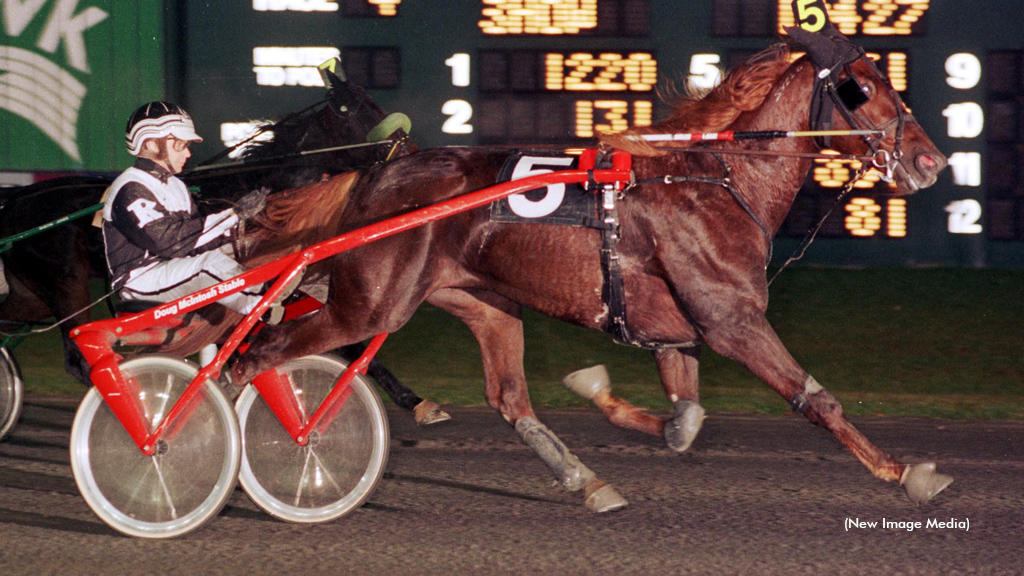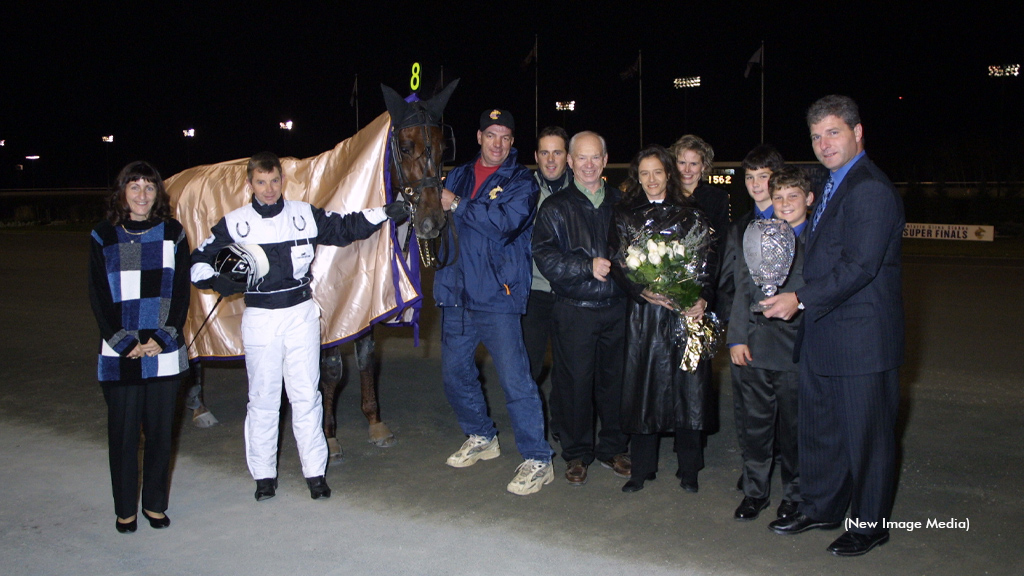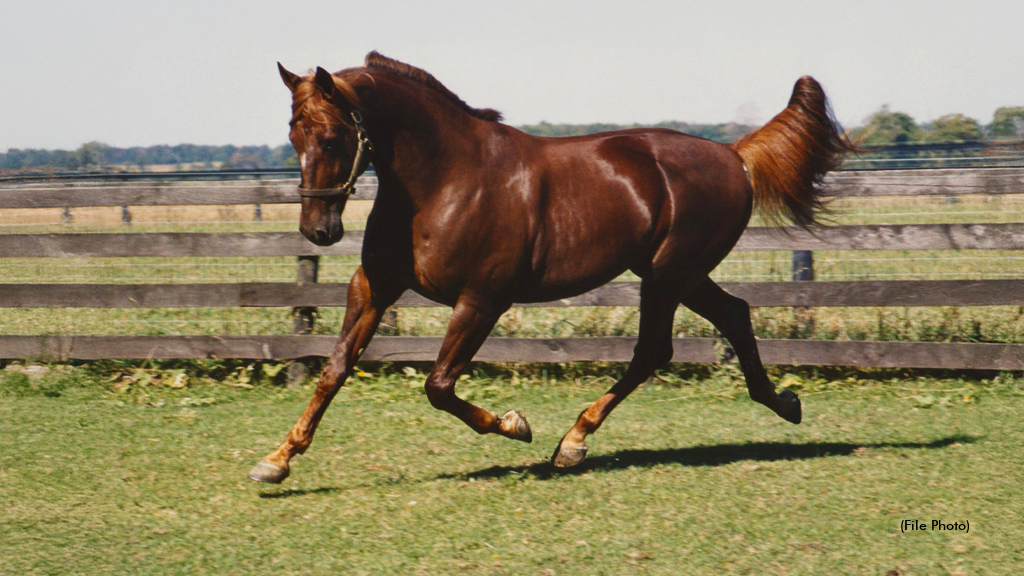Yankee Paco: Canadians’ Career Changing Hambo

On the 25th Anniversary of becoming the first Canadian-sired winner of The Hambletonian, Yankee Paco can now also be called a Canadian Horse Racing Hall Of Famer. The two people that can tell the story of that famous Hambo better than anyone, are trainer Doug McIntosh and driver Trevor Ritchie - so that’s exactly who we asked. They were happy to oblige, and to relive the story of the chestnut son of Balanced Image who changed their lives forever, a quarter-of-a-century ago. By Justin Fisher.

A few seconds can change your life - in this case, 113.2 seconds, to be precise.
When the Doug McIntosh-trained and Trevor Ritchie-driven Yankee Paco won the 2000 Hambletonian, and became the first Canadian-sired horse to win racing’s most prestigious event for sophomore trotters, the careers of the colt’s trainer and driver would never be the same.
A $30,000 yearling purchase from the Kentucky Standardbred Sale, owned by Dr. Tom Ivey and his father Harry, Yankee Paco was under the care of McIntosh, and his groom Reggie, for the entirety of his illustrious racing career, and although he was blessed with great handlers, the road to the pinnacle of racing wasn’t always a smooth one for ‘Paco’, a chestnut son of Balanced Image.
Out of the Speedy Crown dam, Yankee Playgirl, and bred by Yankeeland Farms, the colt faced problems with his gait early on. He actually showed breaks in five of his first eight charted lines before driver Trevor Ritchie took over the reins in October of his freshman campaign.
“I always drove mine at the start, I’m more comfortable with them... but once I think they’re ready, I hand them over to the guys who make the money,” McIntosh said from his home in Wheatley, Ontario.
McIntosh chalked the early miscues up to both immaturity, and the colt not being comfortable with the whole process of racing. He also stated that Yankee Paco’s breeding played a role early on. “I trained a lot of Balanced Images and they were usually kind of unbalanced at the beginning,” laughed McIntosh, “so they were usually better off later. I always said Labour Day was Balanced Image Day. With Paco, he was shy and tentative, but not crazy - he just needed a few more lessons.”
Both Ritchie and McIntosh said that Paco was a horse that you had to know. McIntosh said that he always wanted to hand the reins over to Ritchie eventually, but it had to be the right time. “Giving him to Trevor at just the right time was important for the growth of the horse.”
Clearly, the jump from McIntosh to Ritchie was indeed made at the right time. In his first start with Trevor at the helm, Yankee Paco broke his maiden, as he trotted in 1:58 to collect a victory in a $100,000 Ontario Sires Stakes Gold Final at Mohawk Racetrack.
The neat thing about that victory was how the colt had even qualified for the final to begin with, because he had finished 10th, beaten 32 lengths, after making multiple breaks in his elimination a week earlier. That, however, was in a 12-horse field, with the top 10 finishers moving on to the final, and luckily, two of the other freshmen competitors also made multiple breaks and finished even further back than Paco.
“I really liked him from the start,” Ritchie explained, “but if you would have told me, ‘You’ve got a real Hambo contender here’ I probably would have rolled my eyes.”
When asked about how much more he liked him after guiding him to the maiden-breaking score in the OSS Gold event, the Hall Of Famer who was part of the Class of 2019 said, “Whenever you win a $100,000 race you’re going like the horse.”

The plan, according to McIntosh, was always to race Yankee Paco late into his two-year-old campaign. He said that was normal for him when he was training down Balanced Images, due to the aforementioned late start many of them got.
Paco went on to win four times as a rookie, including his last start of the year, with a win in the $106,800 Canadian Breeders Championship on November 20th. His freshman earnings, from nine starts, would total $124,776.
After having spent the winter before his freshman campaign in the sunny heat of South Florida, McIntosh elected to keep Yankee Paco at his farm in Ontario the winter before his three-year-old year, and after a winning qualifier at Hiawatha Horse Park, with his trainer in the bike, nine days prior, Paco’s first start back at three came in an overnight on May 29th at Mohawk. Unfortunately, the problems that had plagued him early at two seemed to follow him at early at age three as well.
Yankee Paco made a break at the quarter-pole in that first start back, and just five days later he did the same, at the same spot in the mile, in his Connors elimination at Hazel Park.
“That track just wasn’t for him, I don’t think. He had trouble getting his footing and spun out of control,” Ritchie said about the Hazel bobble. “That track there was never very good. It was always deep and cuppy,” recalled Ritchie, who would go on to be named the O’Brien Award winner in 2000 for Driver of the Year in Canada.
After easily requalifying at Mohawk with an 11-length romp, Paco went on to finish second to Plesac in his Canadian Trotting Classic elimination at Woodbine Racetrack on June 17th. It wasn’t until a week later though, after the final, when both Ritchie and McIntosh began to let their minds wander regarding the colt’s ability. At odds of 7/1, and with a late rush from out of the fog, the duo nipped Credit Winner by a head in the $840,100 CTC final, and gave the connections something to think about in regard to what might actually be possible on the first Saturday in August.
“After the Canadian Trotting Classic I thought, ‘This horse is serious’. He didn’t go an easy trip; he battled hard and got up right at the end,” recalled Ritchie. “There were some really good horses in the race, like Credit Winner and Plesac, and we were going for $800,000 that night. That’s when it hit me that he might actually be a contender for the Hambo.”
McIntosh agreed with Ritchie; it was after winning the Canadian Trotting Classic when he first realized that his colt might be extra special.
The longest road trip of the colt’s career - to that point - came next, with a sweep of the OSS Gold elimination and final at Kawartha Downs.
McIntosh then entered his star pupil in the OSS Gold elimination at Windsor on July 19th. With the Hambletonian elimination scheduled for 10 days later, the plan created a possible scheduling conflict of sorts.
“We agreed that if he was awesome in the [OSS] elimination at Windsor, we’d skip the final and go to the Meadowlands for the Hambo,” McIntosh said.
Yankee Paco was indeed awesome in Windsor. In a precursor of what was to come in the near future, he was parked the entire mile and he still won handily. Given the performance, the plan to skip the Windsor Gold final and head south of the border for the first time went into full effect.
One of the biggest benefactors of this plan? Sacre Bleu and Jerry Duford, who may have never won the $100,000 OSS Gold final a week later if Yankee Paco had stuck around.
In New Jersey, on July 29th, Paco, McIntosh and Ritchie drew PP #4 for their Hambo elimination. After having been sent away as the public’s 3/5 choice, the trio took their split fairly handily off of a nice second-over trip, in 1:54.3, but even though the line looked good on paper, Ritchie said that Paco wasn’t necessarily at the top of his game that night. Luckily however, in the year 2000, the Hambletonian format didn’t involve heat racing, so the Canadians had a week to go back to work before the final.
Ritchie would be over-the-moon a week later, with the work McIntosh and Reggie had done on the horse. “He wasn’t very good in the elim, even though he won, and of course I let Doug know once we got off the track. I don’t know what he did in between, but he was awesome the next week, and the result would speak for itself.”
The day of the $1 million classic arrived, and Paco had drawn PP #7. “It’s easy to say now, but the race went pretty smooth… other than the fact I didn’t get the trip I was looking for,” Ritchie said with a chuckle, recalling that the pair, just like two starts earlier in Windsor, never really saw the rail at any point in the race.
“Trevor could give me chills,” laughed McIntosh, when reflecting on the trip Yankee Paco went in the final. “He was a master at keeping a horse calm though. He always looked at the big picture and capitalized on others’ mistakes. In my opinion, Trevor is the most underrated driver of all time.”
“I just wanted to make sure I was still trotting going into the first turn,” Ritchie said. “I looked up and there were still three or four horses on the outside that were in front of me. I thought that not all of them were going to clear, and it would be tough [for all of them] to find a hole - somebody was going to get parked. I had just started to move down to the rail, but I moved back out to hopefully get in the flow, get some cover and get pulled into the race. To my surprise though, Legendary Lover K [his cover] cleared [at the half] and he was never going to let me go, so I had to switch to Plan B.
“I decided to take a hold, sit it out and rate him for as long as possible, until somebody moved from behind… then we’d just go all we could. Paco relaxed for me and trotted nicely. Someone tipped three-wide at the top of the stretch, so then it was time to go and see if we could get the ribbon.”
As they dashed down the lane, Ritchie sat as calm as ever in the bike. He tapped Yankee Paco just four times as Credit Winner closed hard from the outside to get up for second, three-quarters of a length in arrears of the new Hambletonian Champion.
“I was never one to use the whip much,” Trevor related. “My thought is that hitting them will actually slow them down at times. They start thinking about getting hit rather than racing. Yankee Paco always gave it all he had, so the whip wasn’t going to make him go any further. It was a useless tool on him.
“He wasn’t a push-start kind of horse either; Doug kind of worked miracles on that horse,” Ritchie said.
“He had under-developed stifles, so we would jog him 45 minutes each day, no matter the distance,” McIntosh recalled. “We didn’t do a lot of vet work on him either, just ground work and rubbing on him.”
The Hambletonian triumph showed that Ritchie was a reinsman who could deliver in the big moments.

“Paco winning helped my career immensely,” said Ritchie. “My career was somewhat levelling out when Paco came around, and I think his winning helped give my career another five or six years before it levelled out again.”
Ritchie experienced that career-boost just two months later, when he had the most lucrative night of his career, on Breeders Crown night at Mohawk. He finished the night with three ‘Crown’ wins, and two of those came on horses he had never driven prior to the card. Trevor, in-part, credits those catch drives to his triumph months earlier in the Hambletonian.
“The Hambo though, was personally the biggest day for me. In the early ‘70s I worked for Bill Herbert, and I rubbed on Sing Away Herbert. She went down to the Hambo, but I didn’t get to make the trip… that was one of the biggest downers of my career.”
In Ritchie’s mind, the Hambletonian is harness racing’s Gold Standard, and his dream was to simply just race in the revered event.
“It was never a dream to win the race because I never thought it was possible… I guess I was wrong,” said Ritchie. “I’m not an emotional person, but I got a little emotional when I was pulling up - there might have even been a tear in my eye.”
“It was the biggest race you can win, in my opinion” McIntosh said. “The overwhelming support that came from my peers following that was unforgettable. People I hadn’t heard from in years were reaching out afterward.”
Ritchie was scheduled to fly back to Toronto, to drive at Woodbine following the afternoon card at the Meadowlands that day, but once Yankee Paco won, the plans for the evening changed, understandably.
“I phoned the judges after the races and said ‘I hope you guys don’t mind, but I’m going to take tonight off’. They kind of just laughed and said, ‘Fine’ - and I wasn’t even fined,” Ritchie laughed.
Celebrations were necessary - Yankee Paco had just become the first Canadian-sired horse to win America’s biggest trotting race. It was a life-altering day for the connections, who made their way into Manhattan after the card of racing. “It was a good night,” Ritchie said, “to conclude a special day.”
(With files from the Standardbred Canada website)
This feature originally appeared in the June issue of TROT Magazine. Subscribe to TROT today by clicking the banner below.


